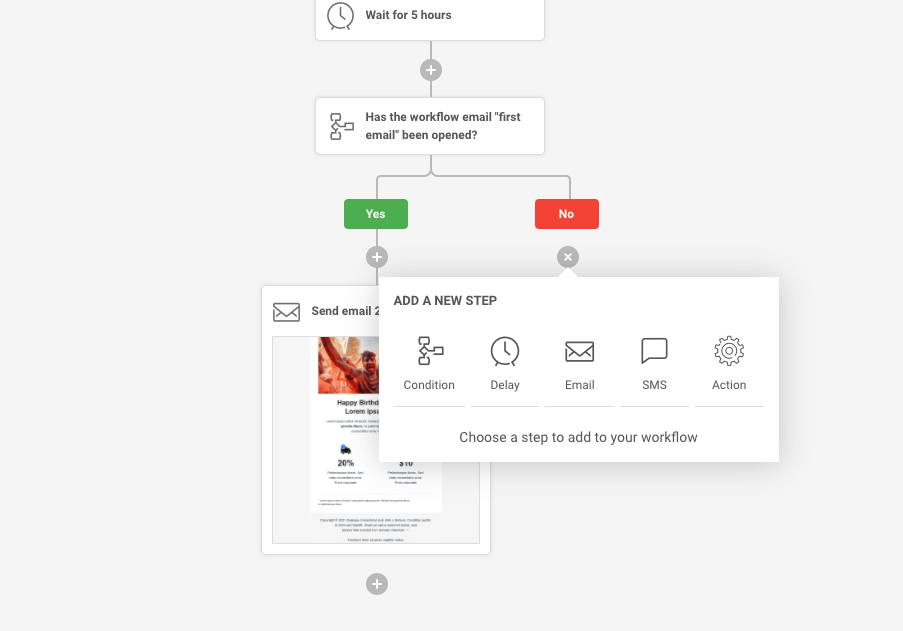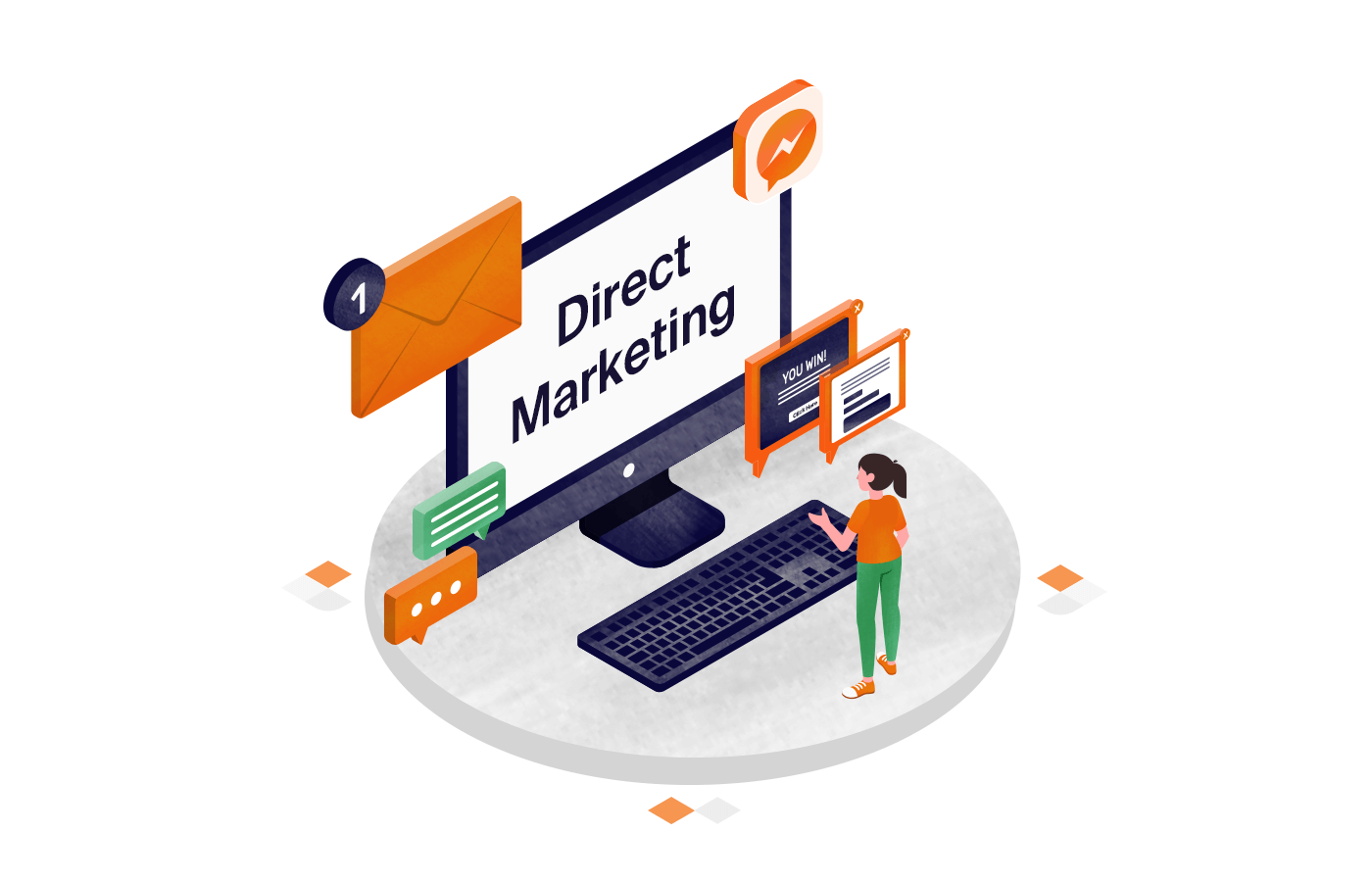Are you tired of shouting into the void of social media, hoping that your message will reach the right people? Well, you don’t have to do that.
With direct marketing, you can reach your target audience through email, direct mail, telemarketing, or even text messages. More personalized and targeted communication leads to higher conversion rates and stronger relationships between your business and customers.
Let’s dive into the world of direct marketing and explore the examples to get inspiration.
What is Direct Marketing? Definition
Direct marketing is a type of advertising where you deliver marketing messages directly to potential customers, usually through email, direct mail, or telemarketing.
The fundamental principles surrounding direct marketing:
- They’re highly targeted — you’re talking to specific customer segments only per campaign;
- They have strong personalization — because you know who you’re talking to, you can address their objections, nurture and convert them better;
- They’re measurable — you can track and attribute each and every dollar. It helps you understand and summarize the ROI of any marketing efforts.
Features of Direct Marketing
To better understand how direct marketing differs from other marketing approaches, we have to take a closer look at its essential elements:
- Targeting. In direct marketing, marketers can directly communicate and engage with their customers, thanks to targeted messages.
- Database segmentation. In direct marketing, it’s common practice to segment the customer database according to specific features and send personalized promotional messages to segmented audiences later.
- Response tracking. Being directly involved in marketing performances allows them to evaluate their efficiency effectively. And to optimize marketing campaigns in return.
The Goal of Direct Marketing
Direct marketing is simple in that you only have to think about one goal – how to convince customers to take action, it doesn’t matter if for lead generation or driving sales. However, the results should be measurable and tangible to understand whether direct marketing efforts succeeded.
Regarding the direct marketing objectives, you should also consider if your efforts will pay off. If your team of intelligent telemarketers costs more than the customers are ready to pay for your products, finding another marketing approach sounds like advice you could use. That’s why direct marketing is here to stay.
The current approach doesn’t bring satisfying results? Try marketing your results via email campaigns. Try marketing on Instagram. Try sending text messages. Find your fit.
How Does Direct Marketing Work?
Businesses use direct marketing to communicate or send sale pitches to a targeted customer base via email, social media, direct mail, or SMS campaigns.
Direct marketing works through well-implemented segmentation and targeting based on recipients’ behavior, demographics, and interests. To increase engagement, many also don’t shy away from message personalization using the recipient’s name.
To sum up, direct marketing efforts are put to:
- Craft high-converting campaigns;
- Create highly targeted messages that allow speaking to specific types of audiences;
- Use personalization to nurture leads better and develop great relationships over time;
- Promote specific products and services or offers more than competitors;
- Get more sales from existing and potential customers.
Direct vs. Indirect Marketing – Key Differences
In direct marketing, you ask prospects and potential customers to buy your product or service proactively. Examples of direct marketing channels include print ads, email marketing campaigns, telemarketing, and more.
In contrast, indirect marketing is a form of marketing where you build awareness and visibility around your business, which translates into business growth over time. Common indirect marketing channels include SEO-optimized blog posts, referrals, and online reviews.
| Direct Marketing | Indirect Marketing |
| Targets a specific audience or customer base | Targets a broad audience |
| Involves direct communication with customers, such as through mail, email, or telemarketing | Involves advertising through mediums like TV, radio, or social media |
| Focuses on generating an immediate response and action from customers | Focuses on building brand awareness and creating a long-term impression |
| Typically utilizes a database of customer information to personalize messages and offers | Relies on market research and analytics to understand the audience and create campaigns |
| Can be more cost-effective as it targets a specific audience and encourages immediate action | Can be more expensive as it aims to reach a larger audience and build brand recognition |
| Offers the ability to track and measure the success of campaigns through metrics such as response rate and conversion rate | Can be more difficult to measure the success of campaigns as they may not result in immediate action from customers |
Both direct and indirect marketing concepts hold meaning for a business as part of an overarching digital marketing strategy.
5 Main Types of Direct Marketing
The most common forms of direct channel marketing fall under both online (digital direct marketing) and offline mechanisms.
The type of direct marketing strategy you choose should be relevant to your business and niche. For example, telemarketing is a form of direct marketing that includes making sales calls to interested prospects.
It may not be great for startups with low budgets or lower-priced products, but it works great for high-ticket clients.
With that in mind, here are 5 direct marketing channel types with examples:
1. Targeted Email Marketing
While social media remains a viable and cost-effective alternative, email marketing ranks among the most profitable direct marketing methods.
Its return on investment (ROI) is $38 for every dollar you invest (or 3,800%). Some 18% of companies even see an ROI of over $70 for every dollar they invest.
Here’s an email example from Apple:

Here are some ways to create an effective email marketing strategy:
- Choose an email marketing tool that meets your needs best. For example, Sender offers great email marketing software for ecommerce and small to medium businesses looking for a high-converting, delivery-optimized solution that doesn’t break the bank.
- Every now and then, take a glance at the way your most successful direct competitor is approaching their email marketing campaign. Leverage the hard work they might have already put in; it might help you avoid obvious and glaring mistakes in your niche.
Start building your first email marketing campaign without any cost! Sender’s Free Forever plan has every feature for you to execute great email marketing.

2. Push Notification Marketing
Push notification marketing is sending marketing communications using push messages.
Push messages are clickable popups you can send to a customer’s desktop, browser, or mobile notification center even if the user hasn’t visited your website or opened your app. They’re broadly divided into two categories: mobile notifications and browser notifications.
Here’s an example:

Using push notifications is a powerful marketing strategy you can use to drive customer engagement by encouraging users to visit your app or website.
With that in mind, here are some push notification best practices you can apply to your marketing campaigns:
- Use the personalization and segmentation features that various browsers provide;
- Use push notifications to remind customers about abandoned shopping carts;
- Add brand icons and images to attract customer attention instantly.
Also read: What is an Email Notification? Definition, Templates
3. Targeted Online Display Ads
Chances are that you’ve already encountered a targeted display ad today. Simply put, targeted display ads are all shapes and sizes of banners (HTML5, video, or static images). They target prospects after various characteristics, including behavior, psychographics, and demographics.
The performance of these types of ads is measured by impression or CPM (Cost Per Mille) and not by how many people clicked on the banner like Pay Per Click (PPC) or Cost Per Click (CPC) ads.
Here’s an example:

Here are valuable tips for creating banner ads that perform:
- Decide on your objective – lead generation, branding, or increasing sales – and target your audience wherever they are in the marketing funnel. Due to its versatility, online advertising can have an impact at any point in the funnel, so it’s much more effective if you reach out to prospects, leads, and existing customers simultaneously.
- The best formula for a banner that works is one image, a compelling headline, and concise copy. In other words, always stick to the point but consider how to grab attention first.
- If you include several types of mediums in your marketing efforts, remember that if something works for one, it might not work for another. For instance, a one-page print ad will hardly look as nice when remade into a banner.
- To optimize your campaign, you must thoroughly test what works best. Perform A/B testing on all aspects of the banner: copy, image, CTA, and display timing, and then use this knowledge for creating upcoming targeted display ads.
Also read: What is Targeted Marketing? Definition, Strategies & Examples
4. Text Message Marketing
Text message marketing uses SMS (Short Message Service) to send marketing and other messages directly to mobile devices. With open rates as high as 98% and response rates as high as 45%, SMS is one of the most affordable ways for businesses to connect with their mobile customers.
You can use text messages for various purposes, including account authentication, reminders, promotions, and notifications about orders.
Here’s an example:

Here are some common direct marketing strategies you can apply to your SMS campaigns:
- Use SMS marketing together with your other customer engagement strategies, such as email and social media marketing and push notifications to boost your marketing campaigns;
- Welcome new opt-ins with sales and promotion offers;
- Test and measure your messaging tactics to improve your SMS campaigns.
Also read: What is an SMS Notification? Definition, Examples
5. Social Media Marketing
Social media marketing uses the power of social media platforms to share information, drive website traffic, increase sales, and build your company’s brand.
You can use social media to make your company an active participant in your industry. Your posts, profile, and interactions with followers can help you form an approachable persona that users can connect with and trust. As a result, you can generate leads and conversions directly on these social platforms.
For example, BuzzFeed’s Tasty videos on Facebook are cooking shows that are typically less than two minutes long. These videos provide on-trend recipes to their highly-engaged audience.
Here’s an example:

Here’s how to create a successful social media strategy:
- Know your audience and what platforms they use, who else they’re following, and what type of marketing materials they like;
- Focus on adding value to users through helpful content, which will help you promote your brand organically;
- Measure your social media activity for quantifiable insights to inform your strategy.
Alternative Forms of Direct Marketing
If you’ve already dipped your toes in previously mentioned direct marketing approaches, you may want to mix up a few things. Here are eight alternative types to consider including in your future campaigns:
1. Direct-Response Marketing
Direct-response advertising is a form of marketing where you give your target audience an offer to persuade them to respond immediately, such as purchase, completing a lead generation form, or downloading an ebook.
Here’s an example of a sales clearance offer from Factory Direct Floor:

Here are some best practices for direct-response marketing:
- Make it simple for your customers to respond to your ads to boost your conversion rates;
- Make the CTA specific so customers know exactly what you want them to do and how to do it;
- Use compelling copy and gripping subject lines to stand out and grab attention.
2. Personal Selling
Personal selling is a type of direct marketing campaign where a salesperson meets a potential customer face-to-face with the goal of selling a service or product.
It’s most common in B2B marketing, although you can also use it in retail.
Some advantages of direct personal selling include:
- You can handle customer objections quickly by tailoring responses to concerns or questions based on specific knowledge of their issues;
- You can use personalized and detailed communication to develop solid relationships and build trust with clients;
- You’re more likely to meet clients’ needs and build loyalty through a solid relationship with them.
3. Telemarketing
Telemarketing is a marketing technique where businesses sell their services or products over the phone. Traditionally, it was done primarily over the phone. However, these days, brands also use videoconferencing, particularly in the later stages of the buying process.
Here are some best practices to help you create successful telemarketing campaigns:
- Define and understand the prospects you intend to contact. Did they enter a trade show prize drawing or open an email about your product?
- Have complete knowledge of your products and be able to overcome objections during a call.
- Listen to customers to build a customer relationship rather than closing the sale.
4. Direct-Response TV Advertising
Direct-Response TV (DRTV) advertising is a type of TV-based marketing that persuades consumers to buy a service or product. Consumers can take action by visiting a website, making a phone call, or purchasing a product.
Here are some direct marketing tips to get the most out of your direct response TV Advertising:
- Have a visible call to action, such as your toll-free phone number and website, onscreen for at least 40 seconds.
- Use the magic price point of $19.95, the most successful price tag for direct-response TV ads.
5. Coupons and Discounts
A coupon is a series of alphanumeric characters made by a computer and can be entered at the checkout stage of online shopping to get a limited-time offer or a discount on the purchase.
Coupons are great marketing tools since they can attract new customers, generate new revenue, and increase customer engagement.
Here’s an example:

Some advantages of coupon codes and discounts include:
- They can quickly drive short-term sales;
- It’s an excellent way to move outdated or excess inventory;
- It can help you generate demand for a new service or product.
6. Newspapers and Magazine Ads
Magazine or newspaper advertising are the ads you see placed throughout publications and are an effective form of communication for both product and brand-specific messages to specific audiences.
Here’s an example:

Ensure you ask the following questions before buying a newspaper or magazine space to advertise:
- What’s the newspaper or magazine’s circulation?
- What are the reader’s demographics?
- How often is the newspaper or magazine published?
7. Outdoor Advertising
Outdoor advertising is the most popular form of traditional marketing. It refers to all outdoor media options, such as posters, billboards, neon sign boards, bus shelter ads, and transit ads.
An excellent outdoor ad campaign sends the right message, to the right audience, at the right place and time since it’s highly relevant and targeted in terms of demographics, location, and consumer behavior.
Here’s an example:

Outdoor advertising is generally a highly effective way to:
- Boost sales, particularly for local businesses;
- Build brand awareness;
- Boost the visibility of a company.
8. Direct Mail Marketing
Direct mail marketing is a type of marketing businesses use to deliver messages physically to customers’ mailboxes through the U.S. Postal Service or another delivery service. Common examples include flyers, catalogs, and postcards. The digital equivalent is email marketing.
Nowadays, the majority of marketing is done digitally. However, when done well, direct mail marketing can complement your other channels to build customer relationships and help your business stand out.
Here are some ways to create effective direct marketing campaigns:
- Define your audience to determine who your product is best suited for, then focus your marketing efforts on them;
- Ensure you have a call-to-action (CTA) to direct customers on what to do after receiving your mail;
- Monitor how many prospects respond to your direct mail, then follow up with them later.
Also read: What is Online Advertising? Definition, Benefits & Examples
Key Takeaways
- Direct marketing is a targeted advertising approach that delivers marketing messages directly to potential customers through email, direct mail, telemarketing, and door-to-door;
- Direct marketing campaigns have strong personalization, target specific customer segments, and are measurable;
- Direct marketing is more cost-effective, generates immediate action from customers, and is highly measurable compared to indirect marketing;
- The type of direct marketing strategy you choose should be relevant to your business and niche, and it’s important to monitor the response rates and follow up with prospects.
Also read:
- What is Promotion Mix Marketing? Best Examples & Practice
- What is Ecommerce Marketing? Definition, Strategies
Author Bio
Billy Njogu is a content writer focused on helping B2B tech companies engage their audience by delivering content that solves their problems. His drive for excellence makes him exceed expectations to ensure his clients’ success. In his free time, you’ll find Billy reading about investing and real estate.
